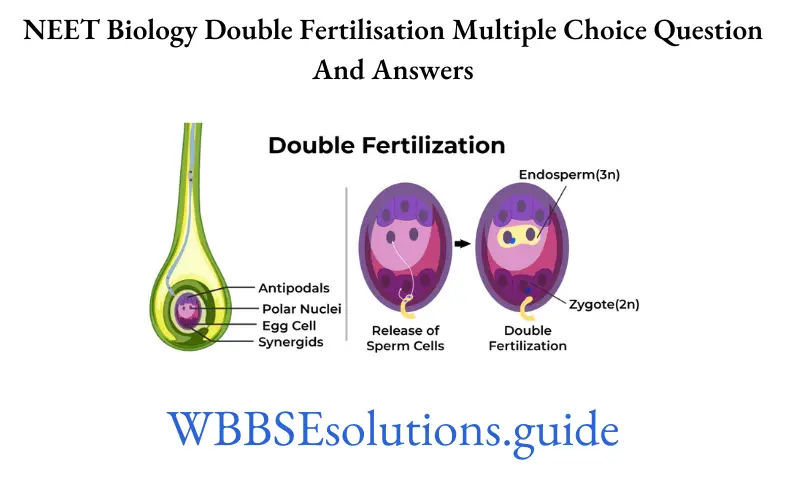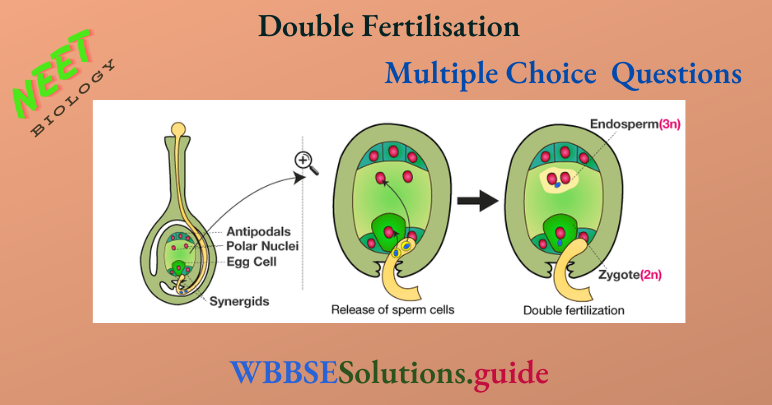Biology MCQs with answers for NEET Double Fertilisation
Question 1. Double fertilisation in angiosperms was discovered by
- JC Bose
- Strasburger
- Maheshwari
- Nawaschin
Answer: 4. Nawaschin
Double fertilisation was discovered by Sergei Nawaschin and Grignard in 1898 in France.
Read And Learn More: NEET Biology Multiple Choice Question And Answers
Question 2. Double fertilisation is
- Fusion of two male gametes of a pollen tube with two different eggs
- Syngamy and triple fusion
- Fusion of two male gametes with one egg
- Fusion of one male gamete with two polar nuclei
Answer: 2. Syngamy and triple fusion
Double fertilisation is a unique phenomenon that occurs in angiosperms only. It involves two types of fusion, i.e. syngamy and triple fusion.
Question 3. Double fertilisation is exhibited by
- Gymnosperms
- Algae
- Fungi
- Angiosperms
Answer: 4. A distinguishing feature of angiosperms is the occurrence of double fertilisation.
Question 4. Number of nuclei taking part in double fertilisation is
- 2
- 3
- 4
- 5
Answer: 4. 5
Nuclei taking part in double fertilisation, i.e. 2 sperm nuclei, 2 polar nuclei, and 1 egg nucleus.

Question 5. Syngamy is the process by which
- Pollen tube enters the ovule through chalaza
- Fusion of male gamete with female gamete
- Pollen tube enters the ovule through micropyle
- None of the above
Answer: 2. Fusion of male gamete with female gamete
Syngamy is union or fusion of male and female gametes during the process of sexual reproduction to form a diploid cell, the zygote (also called fertilisation)
Question 6. Sperm and egg nuclei fuse due to
- Base pairing of their DNA and RNA
- Formation of hydrogen bonds
- Mutual attraction
- Attraction of their protoplasts
Answer: 4. Attraction of their protoplasts
Sperm or male gamete fuses with egg or female gamete because of the attraction of their protoplasts. Some chemicals are secreted by ovule or egg wall to attract the male gamete or sperm.
Biology MCQ For NEET With Answers

Question 7. What is the fate of the male gametes discharged in the synergid?
- One fuse with egg other(s) degenerate (s) in the synergid
- All fuse with the egg
- One fuses with the egg, other(s) fuse(s) with synergid nucleus
- One fuses with the egg and other fuses with central cell nuclei
Answer: 4. One fuses with the egg and other fuses with central cell nuclei
In flowering plants, out of the two male gametes discharged in synergids, one fuses with the egg to form zygote, and other fuses with the secondary or definitive nucleus present in central cell to form primary endosperm nucleus.
Question 8. Triple fusion means fusion of
- Two polar bodies with male gametes
- Two eggs with male gametes
- Two male gametes and one egg
- Two male gametes, one egg, and secondary nucleus
Answer: 1. Two polar bodies with male gametes
- Triple fusion means fusion involving two polar nuclei with male gametes in the embryo sac that results in the formation of the endosperm.
- It is a peculiar characteristic in double fertilisation where diploid zygote and a triploid endosperm are formed. So, the correct option is 1.
Question 9. After double fertilisation, a mature ovule has
- 1 diploid and 1 haploid cell
- 1 diploid and 1 triploid cell
- 2 haploid and 1 triploid cell
- 1 haploid and 1 triploid cell
Answer: 2.1 diploid and 1 triploid cell
- After double fertilisation, a mature angiospermous ovule contains one diploid cell (zygote) and one triploid cell (endosperm).
- The haploid cells of the ovule such as antipodals and synergids degenerate after fertilisation.
NEET Biology Mcq
Question 10. Secondary nucleus of angiosperm is
- n
- 2n
- Both (1)and (2)
- 3n
Answer: 2. 2n
The ploidy of the central cell of embryo sac is diploid (2n) because, during the formation of female gametophyte in angiosperms, one nucleus from each pole (polar nuclei) migrates to the center and fuses with each other thus, forming a secondary nucleus
Question 11. What is the product of double fertilisation and triple fusion in Capsella?
- 3X Oospore and 2X endosperm
- 2X Oospore and 2X endosperm
- 2X Oospore and 3X endosperm
- 3X Oospore and 3X endosperm
Answer: 3. 2X Oospore and 3X endosperm
- In Capsella as a result of double fertilisation, 2X oospore is formed. Along with that triple fusion takes place and results in the formation of triploid 3X endosperm.
- It performs the function of providing nourishment. So, the correct answer is 2X oospore and 3X endosperm.

